Pashto alphabet
The Pashto alphabet (پښتو الفبې) is transliterated vis-à-vis Perso-Arabic scriptural denotation with additional glyphs added to accommodate phonemes used in Pashto.
| Pashto alphabet |
|---|
| ﺍ ﺏ پ ﺕ ټ ﺙ ﺝ چ ﺡ ﺥ څ ځ ﺩ ډ ﺫ ﺭ ړ ﺯ ژ ږ ﺱ ﺵ ښ ﺹ ﺽ ﻁ ﻅ ﻉ ﻍ ﻑ ﻕ ک ګ ﻝ ﻡ ﻥ ڼ ﻭ ه ۀ ي ې ی ۍ ئ |
|
Extended Arabic script |
History
Roshani script
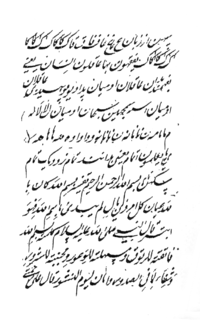
In the 16th century, Bayazid Pir Roshan from Waziristan invented the Roshani script to write Pashto. It had 41 letters:
| ا ā, ’ /ɑ, ʔ/ | ب b /b/ | پ p /p/ | ت t /t̪/ | ټ ṭ /ʈ/ | ث s /s/ | ج j /d͡ʒ/ | چ č /t͡ʃ/ | څ c /t͡s/ | ح h /h/ | خ x /x/ |
| د d /d̪/ | ډ ḍ /ɖ/ | ڊ ź /d͡z/ | ﺫ z /z/ | د· ẓ̌ /ʐ/ | ﺭ r /r/ | ړ ṛ /ɺ˞~ɻ/ | ﺯ z /z/ | ږ ž /ʒ/ | ||
| ڛ s /s/ | س s /s/ | ش š /ʃ/ | ښ ṣ̌ /ʂ/ | ص s /s/ | ض z /z/ | ط t /t̪/ | ظ z /z/ | ع ’ /ʔ/ | غ ğ /ɣ/ | |
| ف f /f/ | ق q /q/ | ک k /k/ | ګ g /ɡ/ | ل l /l/ | م m /m/ | ن n /n/ | ڼ ṇ /ɳ/ | و w, ū, ō /w, u, o/ | ه h, a, ə /h, a, ə/ | ي y, ī, ē /j, i, e/ |
28 of his letters came from the Arabic alphabet. He introduced 13 new letters into the Pashto alphabet. Most of the new letters he introduced i.e. ګ ,ښ ,ړ ,ډ ,څ ,ټ and ڼ are still written in the same form and are pronounced almost in the same way in modern Pashto. The sound system of the southern dialect of modern Pashto preserves the distinction between all the consonant phonemes of his orthography.
Pir Roshan also introduced the letter ږ (rē with dot below and dot above) to represent /ʒ/, like the ⟨s⟩ in pleasure, for which modern Pashto uses ژ instead. Modern Pashto uses the letter ږ to represent the sound /ʐ/ (northern dialect: /g/), but for that sound, Pir Roshan used a letter looking like ·د (dāl with central dot). His letter ڊ (dāl with dot below) to represent /d͡z/ has been replaced by ځ in modern Pashto. He also used ڛ (sīn with three dots below), an obsolete letter from the medieval Nastaʿlīq script, to denote the letter س (representing /s/) only in the isolated form. The Arabic ligature ﻻ (lām-alif) was also used. Two of his letters, پ and چ, were borrowed from the Persian alphabet.
Form
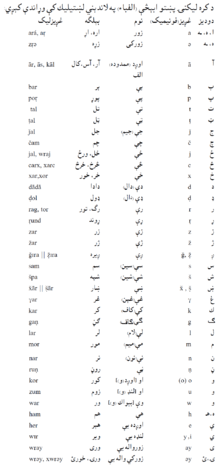
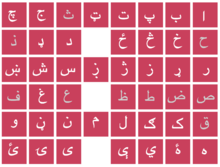

Pashto is written in the Arabic Naskh. It has several letters which do not appear in any other Arabic script. The letters representing the retroflex consonants /ʈ/, /ɖ/, /ɭ̆/ and /ɳ/ are written like the standard Arabic te, dāl, re and nun with a small circle attached underneath (known as a "panḍak", "ğaṛwanday" or "skəṇay"): ړ, ډ, ټ, and ڼ, respectively. The letters ښ and ږ (x̌īn/ṣ̌īn and ǵe/ẓ̌e) look like sīn (س) and re (ﺭ) respectively with a dot above and beneath.
The letters representing /t͡s/ and /d͡z/ look like a ح with three dots above and an hamza (ء) above; څ and ځ.
Pashto has ی, ې, ۀ, and ۍ for additional vowels and diphthongs as well.
Pashto uses all 28 letters of the Arabic alphabet, and shares 3 letters (چ, پ, and ژ) with Persian and Urdu in the additional letters.
Letters
Pashto has 45 letters and 4 diacritic marks. The Southern (S), Central (C) and Northern (N) dialects of Pashto are included.
| Name | IPA | Transliteration | Contextual forms | Isolated | ALA-LC Romaniz. |
Latin | Unicode (Hex) |
Remarks | |||
|---|---|---|---|---|---|---|---|---|---|---|---|
| Symbol | Examples | Final | Medial | Initial | |||||||
| alep or alif | [ɑ] | bark | ā | ـا | ـا | آ, ا | آ, ا | ā | Ā ā | U+0627, U+0622 |
|
| be | [b] | born | b | ـب | ـبـ | بـ | ب | b | B b | U+0628 | |
| pe | [p] | peel | p | ـپ | ـپـ | پـ | پ | p | P p | U+067E | |
| te | [t̪] | think | t | ـت | ـتـ | تـ | ت | t | T t | U+062A | |
| ṭe | [ʈ] | total | ṭ | ـټ | ـټـ | ټـ | ټ | ṭ | Ṭ ṭ | U+067C | same pronunciation of ط in Modern Standard Arabic |
| se2 | [s] | biscuit | s | ـث | ـثـ | ثـ | ث | s̱ | S s | U+062B | historically the original Arabic pronunciation lost, |
| jīm | [d͡ʒ] | jug | j (or ǰ) | ـج | ـجـ | جـ | ج | j | J j | U+062C | |
| če | [t͡ʃ] | cheese | č | ـچ | ـچـ | چـ | چ | ch | Č č | U+0686 | |
| he2 | [h] / [x]3 | house | h | ـح | ـحـ | حـ | ح | ḥ | H h | U+062D | |
| xe | [x] | loch (Scottish) | x | ـخ | ـخـ | خـ | خ | kh | X x | U+062E | |
| ce | [t͡s] / [s] | cats | ts (or c) | ـڅ | ـڅـ | څـ | څ | ṡ | C c | U+0685 | |
| źim | [d͡z] / [z] | adze | dz (or j) | ـځ | ـځـ | ځـ | ځ | ż | Ź ź | U+0681 | same pronunciation of ض in Modern Standard Arabic |
| dāl | [d̪] | dull | d | ـد | ـد | د | د | d | D d | U+062F | |
| ḍāl | [ɖ] | ḍ (or dd) | ـډ | ـډ | ډ | ډ | ḍ | Ḍ ḍ | U+0689 | same pronunciation of doubling دّ in Modern Standard Arabic | |
| zāl2 | [z] | zoo | z | ـذ | ـذ | ذ | ذ | ẕ | Z z | U+0630 | historically the original Arabic pronunciation lost, |
| re | [r] | rain | r | ـر | ـر | ر | ر | r | R r | U+0631 | |
| ṛe4 | [ɺ̢] (ɭ̆), [ɻ] | ṛ (or rr) | ـړ | ـړ | ړ | ړ | ṛ | Ṛ ṛ | U+0693 | same pronunciation of doubling رّ in Modern Standard Arabic | |
| ze | [z] | zoo | z | ـز | ـز | ز | ز | z | Z z | U+0632 | |
| že | [ʒ] / [d͡z] | vision, delusion | ž | ـژ | ـژ | ژ | ژ | zh | Ž ž | U+0698 | similar pronunciation of ذ in Modern Standard Arabic |
| ẓ̌e (S) ǵe (C, N) |
[ʐ] (S) [ʝ] (C) [ɣ] (N) |
ẓ̌ (S) γ̌/ǵ (C) ğ (N) |
ـږ | ـږ | ږ | ږ | ẓh (S) g'h (C) gh (N) |
Ǵ ǵ (or Ẓ̌ ẓ̌) | U+0696 | ||
| sīn | [s] | biscuit | s | ـس | ـسـ | سـ | س | s | S s | U+0633 | |
| šīn | [ʃ] | shoot | š | ـش | ـشـ | شـ | ش | sh | Š š | U+0634 | |
| ṣ̌īn (S) x̌īn (C, N) |
[ʂ] (S) [ç] (C) [x] (N) |
ṣ̌ (S) x̌ (C) x (N) |
ـښ | ـښـ | ښـ | ښ | ṣh (S) k'h (C) kh (N) |
X̌ x̌ (or Ṣ̌ ṣ̌) | U+069A | ||
| swād2 | [s] | surf | s | ـص | ـصـ | صـ | ص | s | S s | U+0635 | historically the original Arabic pronunciation lost, |
| zwād2 | [z] | z | ـض | ـضـ | ضـ | ض | z | Z z | U+0636 | historically the original Arabic pronunciation lost, | |
| twe2 | [t] | t | ـط | ـطـ | طـ | ط | t | T t | U+0637 | historically the original Arabic pronunciation lost, | |
| zwe2 | [z] | z | ـظ | ـظـ | ظـ | ظ | z | Z z | U+0638 | historically the original Arabic pronunciation lost, | |
| ayn2 | [ɑ] | bark | a | ـع | ـعـ | عـ | ع | ʻ | nothing | U+0639 | historically the original Arabic pronunciation lost,
soften like in Farsi or Dari, sounding like a glottal stop instead of guttural |
| ğayn | [ɣ] | gh (or γ) | ـغ | ـغـ | غـ | غ | gh | Ğ ğ | U+063A | ||
| pe or fe2 | [f] / [p]5 | peel | f | ـف | ـفـ | فـ | ف | f | F f | U+0641 | |
| kap or qāf | [q] / [k]6 | keep | q | ـق | ـقـ | قـ | ق | q | Q q | U+0642 | |
| kāf | [k] | keep | k | ـک | ـکـ | کـ | ک 7 | k | K k | U+06A9 | |
| gāf | [ɡ] | get | g | ـګ | ـګـ | ګـ | ګ 8 | g | G g | U+06AB | |
| lām | [l] | lamb | l | ـل | ـلـ | لـ | ل | l | L l | U+0644 | |
| mīm | [m] | minute | m | ـم | ـمـ | مـ | م | m | M m | U+0645 | |
| nūn | [n] | near | n | ـن | ـنـ | نـ | ن | n | N n | U+0646 | |
| ṇūn | [ɳ] | ṇ (or nn) | ـڼ | ـڼـ | ڼـ | ڼ | ṇ | Ṇ ṇ | U+06BC | same pronunciation of doubling نّ in Modern Standard Arabic | |
| wāw | [w], [u], [o] | watch , boot (General American),
go(General American) [Note: [o] is not lengthened] |
w, ū, o | ـو | ـو | و | و | w, ū, o | W w, Ū ū, O o | U+0648 | |
| gərda he round hē |
[h], [a] | hey ; stuck (Cockney) | h, a | ـه | ـهـ | هـ | ه | h, a | H h, A a | U+0647 | |
| kajīra he idiosyncratic hē |
[ə] | bird (Received Pronunciation) | ə | ۀ | – | – | ۀ 13 | ə | Ə ə | U+06C0 | |
| klaka ye hard yē |
[j], [i] | yacht; week (General American) | y, ī | ـي | ـيـ | يـ | ي | y, ī | Y y, Ī ī | U+064A | |
| pasta ye soft yē |
[e] | eight [Note: [e] is not lengthened] | ē | ـې | ـېـ | ېـ | ې 9 | e | E e | U+06D0 | |
| nārīna ye masculine yē |
[ai], [j]10 | guy | ay, y | ـی | ـ | ـ | ی 9 | ay, y | Ay ay, Y y | U+06CC | |
| x̌əźīna ye feminine yē |
[əi] | əi | ـۍ | ـ | ـ | ۍ 10 | ạy | Əi əi | U+06CD | ||
| fāiliya ye / kaṛa ye verbal yē |
[əi], [j]12 | əi, y | ـئ | ـئـ | ئـ | ئ 9,12 | ạy, y | Əi əi, Y y | U+0626 | ||
Notes
- ^1 In the beginning of a word, آ (alif with madda) represents the long vowel /ɑ/ in words borrowed from other languages (e.g. آغا – āğā, a title).[2] In the beginning of a word, the alphabet ا (alif) represents the consonant /a/, e.g. اسپه – aspa, "mare".[3] In the middle or end of a word, ا represents the long vowel /ɑ/ which is following a consonant (e.g. کال – kāl, "year"; and نيا – nyā, "grandmother").[4][5] In the beginning of a word, the alphabet Alif can also be used with a diactric mark [often not written] e.g. اِ (alif with a zer) as in اِسلام – Islām, "Islam (the religion)".[6]
- ^2 Ten letters, ق ف ع ظ ط ض ص ح ﺫ ث, appear only in loanwords which of Arabic origin through Persian borrowings. Eight of these, ع ظ ط ض ص ح ﺫ ث, represent no additional phonemes of Pashto, and their pronunciation is replaced with other phonemes.
- ^3 ح /h/ tends to be omitted in pronunciation when at the end of a word, e.g. اصلاح is always pronounced as [isˡlɑ].
- ^4 The letter ړ represents /ɺ̢/ if it is not at the final position of a syllable; if it is final, it represents /ɻ/.
- ^5 The phoneme /f/ ف occurs only in loanwords. It tends to be replaced with /p/ پ.
- ^6 The phoneme /q/ ق occurs only in loanwords. It tends to be replaced with /k/ ک.
- ^7 It is also common to write the letter ک as ك.
- ^8 It is also common to write the letter ګ as گ.
- ^9 In informal texts, ی as well as ې, ۍ and ئ are sometimes replaced by the letter ے, especially in Khyber Pakhtunkhwa. In some official texts, edited till to the middle of the 20th century, the ے corresponds only to ې, while ۍ and ئ (if only the grammatical use of the latter is not lacked) are used as in official typing nowadays.
- ^10 ی represents /ai/ when it is following a consonant (e.g. لرګی – largay, "wood"), and represents /j/ when it is following a vowel (e.g. دوی – duy, "they").
- ^11 The letter ئ represents /j/ after a vowel, e.g. جدائي – judāyī, "separation".
- ^12 It is also common to write ﺉ with the hamza over the right side of the letter – ٸ.
- ^13 The letter ۀ is only represented at the end of a word, e.g. تېرۀ – terə, "sharp". The vowel /ə/ when present between consonants is unrepresented by the ۀ alphabet, e.g. ننوتل – nənawatəl, "to enter".
- ^14 Pashtuns tend to omit or not pronounce the letter غ and some words, e.g. consider the following words; دغه = دا، دغوی = دوی، دغه هومره = دومره، دغلته = دلته، هغلته = هلته، دغه سی = داسی
Historical letters now in disuse
The superscribed element of the letter ځ in earlier varieties was not hamza-shaped, but was very similar to little kāf of the letter ك.[7] Such shape of the upper element of the letter is hard to find in modern fonts.
Since the time of Bayazid Pir Roshan, ڊ (dāl with subscript dot) was used for /d͡z/, which was still used in the Diwan of Mirza written in 1690 CE,[1] but this sign was later replaced by ځ.
Another rare glyph for /d͡z/ is ج֗, a ج with the same dot above.
Diacritic marks
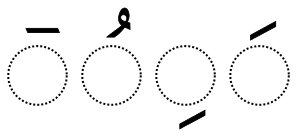
The four diacritic marks are:
| Diacritic | Unicode | Name | Translit. | IPA | Latin |
|---|---|---|---|---|---|
| َ | U+064E | zwar | a | [a] | a |
| ٙ | U+0659 | zwarakay | ə | [ə] | ə |
| ِ | U+0650 | zer | i | [i] | i |
| ُ | U+064F | peš | u | [u] | u |
Notes
- The diacritic marks are not considered separate letters. Their use is optional and are usually not written; they are only occasionally used to distinguish between two words which would otherwise appear similar.
- In Arabic loanwords, the tanwin fatha (ً) can be used, e.g. مَثَلاً – masalan, "for example".
"Ye" letters
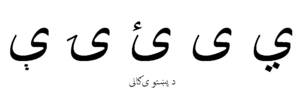
| Letter | Pashto name | Unicode name | Transliteration | IPA | Position in a word | Example |
|---|---|---|---|---|---|---|
| ي | klaka ye | ARABIC LETTER YEH | y, ī | [j], [i] | can appear anywhere | يم yəm ('I am') |
| ې | pasta ye | ARABIC LETTER E | e | [e] | middle or end | يې ye ('you (sing.) are') |
| ی | nārīna ye1 | ARABIC LETTER FARSI YEH | ay when following a consonant | [ai] | end | ستوری storay ('star') |
| y when following a vowel | [j] | end | دوى duy ('they') | |||
| ۍ | x̌əźīna ye2 | ARABIC LETTER YEH WITH TAIL | əi | [əi] | end | وړۍ waṛəi ('wool') |
| ئ | fāiliya ye3 | ARABIC LETTER YEH WITH HAMZA ABOVE | əi | [əi] | end | يئ yəi ('you (plur.) are') |
| y | [j] | middle | جدائي judāyī ('separation') |
Indications
- ^1 If ى follows a consonant in a word, it indicates the word is masculine singular and in the direct case.
- ^2 ۍ always indicates the word it occurs in is feminine.
- ^3 If ئ occurs at the end of a verb, it indicates the verb is in second person plural form. Note, that sometimes the grammatical ئ was lacked either in the typing as in the alphabet and replaced with the ۍ.
See also
- Pre-Islamic scripts in Afghanistan
- Perso-Arabic alphabet
References
- D. N. MacKenzie, "A Standard Pashto", Khyber.org
- Pashto-English Dictionary
- Pashto-English Dictionary
- Pashto-English Dictionary
- Pashto-English Dictionary
- mohammedanisme in Dutch and Flemish-Pashto Dictionary
- Ivanov, Vladimir; Novgorodova, Irina. "L2/01-316. Arabic Letter Final/Isolated Kaf Sign" (PDF). www.unicode.org. Unicode, Inc.
Bibliography
- Awde & Sarwan (2002). "Pashto dictionary & phrasebook", page 24.